Table of contents
- The most important facts about cornering Faster, better, safer
- Interesting facts about curves
- Game between asphalt and rubber – a tightrope act?
- The Kamm circle
- Into the curve – the three phases
- Cornering – that’s the right way to do it
- Common mistakes when cornering
- Our best moments
- Disagreement with the guardrail
- “A curve is the loveliest distance between two points”
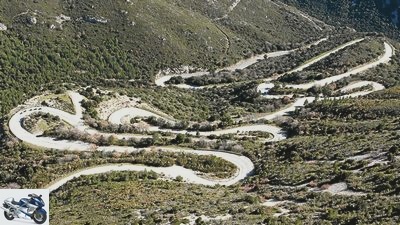
Jahn
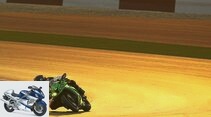
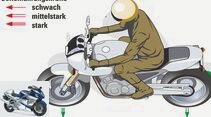
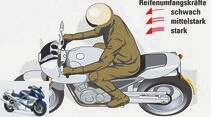
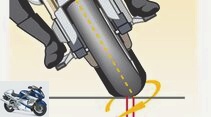
28 pictures
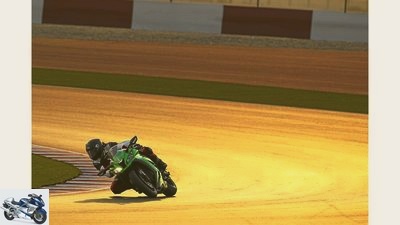
Kawasaki
1/28
Curves are the icing on the cake for motorcyclists. Without them, life on two wheels would be bland.
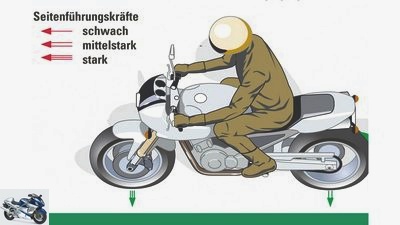
Muller
2/28
3. Green phase: Accelerating from an incline.
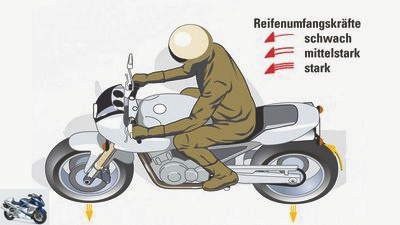
Muller
3/28
2. Yellow phase: inclined position in roll phase.
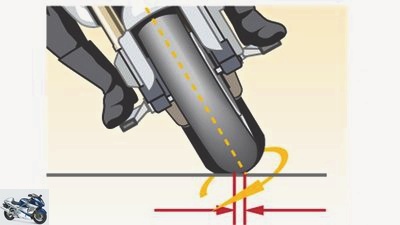
Muller
4/28
2. Yellow phase: inclined position in roll phase.
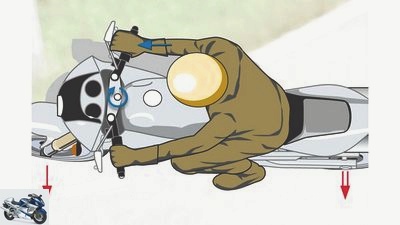
Muller
5/28
1. Red phase: The so-called set-up moment, caused by the contact area of the front tire that is off-center to the steering axis, must be compensated by the driver with a counter-steering force (blue arrow).
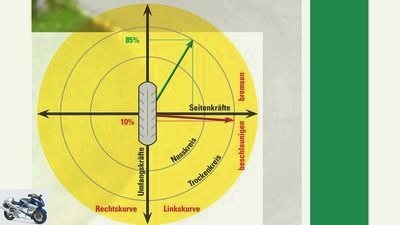
Muller
6/28
The Kamm circle.
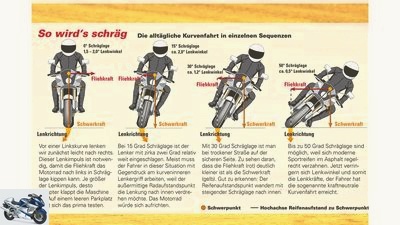
Muller
7/28
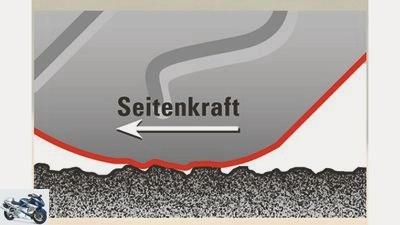
Muller
8/28
… Only when the temperature rises does the warm tread of the tire (red) form an almost form-fitting contact with the road.

Muller
9/28
If the tire temperatures are too low, special rubber compounds can cause glass behavior. The rubber is too hard to interlock with the rough surface (blue) …
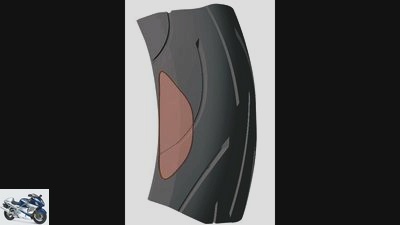
Muller
10/28
The tire contact area, the so-called Laces (red), creates the contact between the road and the motorcycle. The sketch shows a 180 mm sports tire with a pointed tire contour at a lean angle of 48 degrees.
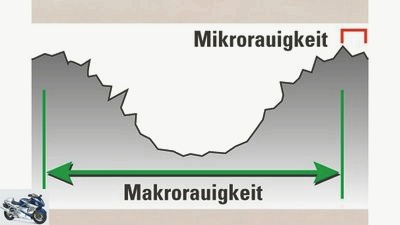
Muller
11/28
The micro-roughness improves the grip especially in wet conditions, while the macro-roughness improves the coarse toothing on dry roads.
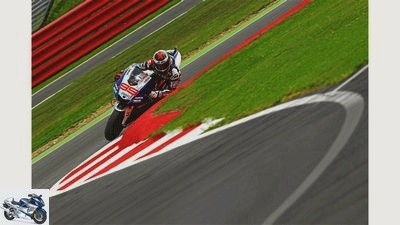
2snap
12/28
Jorge Lorenzo.
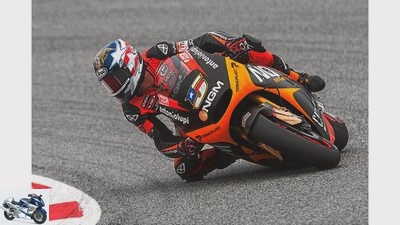
2snap
13/28
Colin Edwards
Turn 1, Phillip Island 4th gear, 150 km / h.
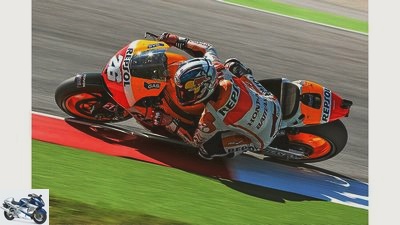
2snap
14/28
Dani Pedrosa
Sito Pons, Jerez, 3rd gear, 130 km / h.

2snap
15/28
Mick Doohan
Stoner Corner, Phillip Island 5th gear, 228 km / h.
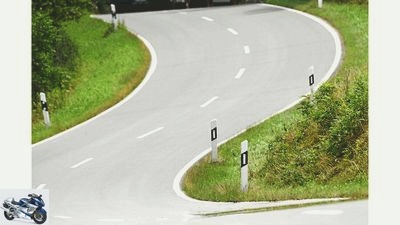
Artist
16/28

mps photo studio
17/28
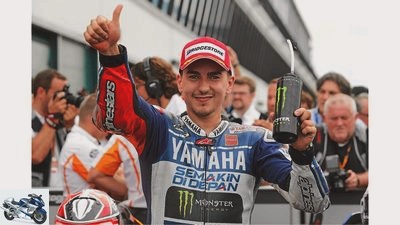
2snap
18/28
Jorge Lorenzo
Turn 12, Phillip Island 4th gear, 145 km / h.
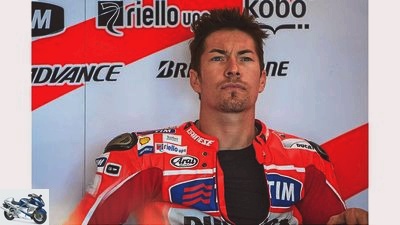
2snap
19/28
Nicky Hayden
Turn 1, Springfield Mile last gear, 202 km / h.
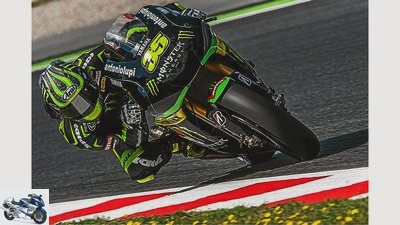
2snap
20/28
Cal Crutchlow
Turn 12, Phillip Island 4th gear, 145 km / h.
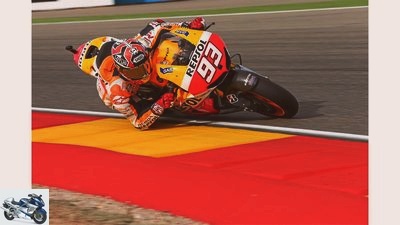
2snap
21/28
Marc Marquez
Turn 5, Indianapolis 4th gear, 177 km / h.
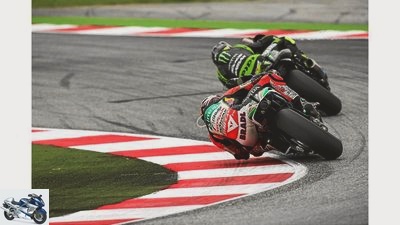
2snap
22/28
Stefan Bradl
Turn 12, Phillip Island 4th gear, 145 km / h.
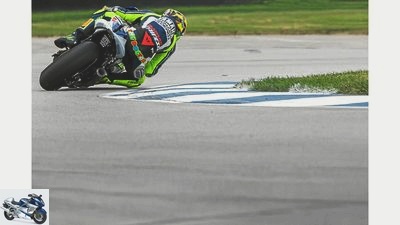
2snap
23/28
Valentino Rossi
Casanova / Savelli, Mugello 3rd gear, 137 km / h.
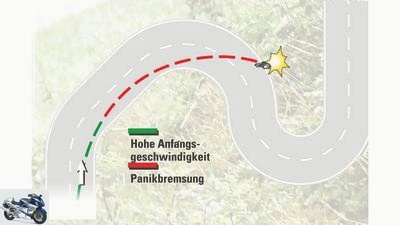
Muller
24/28
The consequences of “freezing” on the brakes are no less serious.
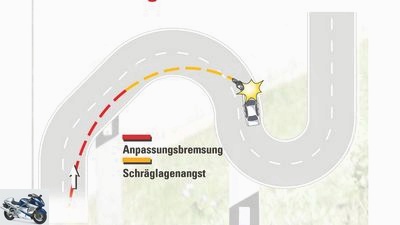
Muller
25/28
The classic among driving errors: the fear of a great lean angle.
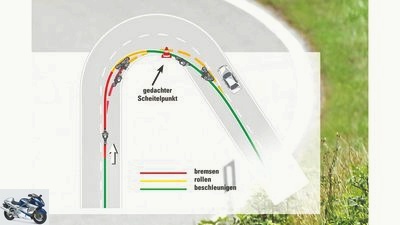
Muller
26/28
The classic curve.
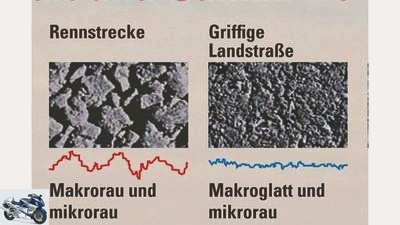
Muller
27/28
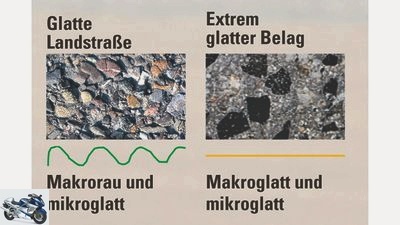
Muller
28/28
counselor
Driving experience & Driving tips
Correct cornering with the motorcycle
The most important facts about cornering
Faster, better, safer
Content of
Curves are the icing on the cake for motorcyclists. Without them, life on two wheels would be bland. But every curve is a challenge for man, machine and physics. A little basic knowledge doesn’t hurt.
Uwe Seitz
October 15, 2013
Interesting facts about curves
“Boom, and already I was. I don’t know how that could happen, it happened so quickly.” Anyone who has ever landed on a motorcycle in a field, dirt, gravel bed, ditch or anywhere else knows the feeling. And it’s not a pretty one. Nowhere else do exhilaration and drama come together as closely as when driving a motorcycle around corners. Therefore, it is not wrong to know a few important things about curves.
Buy complete article
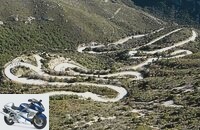
The most important facts about cornering
Faster, better, safer
16 pages) as PDF
€ 2.00
Buy now
Game between asphalt and rubber – a tightrope act?
The so-called micro-roughness, the roughness depth of which can be between 0.001 and 0.1 millimeters, significantly improves grip, especially in wet conditions, while the macro-roughness is between 0.1 and 10 millimeters and mainly improves the coarse toothing on dry roads.
The tire contact area, the so-called Laces, creates the contact between the road and the motorcycle. The tire’s cornering force results from approximately 38 square centimeters of contact area. Most of the time, just a part of a tire the size of a credit card has contact with the ground.
The road looks rough like a rasp. Nevertheless, for motorcyclists it may be as smooth as soft soap – especially when it is wet. This is because rough surfaces do not mean good grip. The fine in between, the microstructure, is crucial. A surface with the finest stones at the right height between the coarse stones is ideal, so that the tire is maximally connected to the road. A racing surface is therefore made of bitumen mixed with stones of different sizes. Attention: On freshly paved roads, bitumen particularly overlays the micro-roughness. It takes a few weeks for the base to wash out and provide good grip.
If tire temperatures are too low, special rubber compounds, for example for use in sports, can lead to glass behavior. The rubber is too hard to interlock with the rough surface. Only when the temperature rises does the warm tread of the tire form an almost form-fitting contact with the road.
The Kamm circle
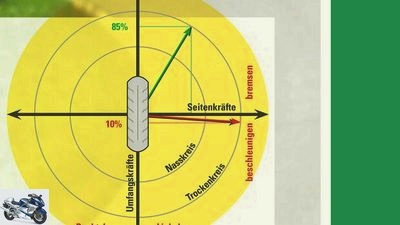
Muller
The Kamm circle.
You should have heard the name before and perhaps understood what it is about. However, knowing about him neither makes us faster nor more weird – at least not on a motorcycle, because people stand between theory and practice. However, the Kamm circle clearly shows the ratio of lateral and circumferential forces to the tire and the available static friction.
The green line shows a typical country road trip. With lateral forces of around 50 percent, which corresponds to an incline of around 35 degrees, 85 percent of the circumferential forces of the tire can still be used to brake or accelerate. The red arrow is for racers. Here is really inclined (approx. 57 degrees). 99 percent of the cornering forces have been used up, and only 10 percent are left for gentle acceleration. If you accelerate harder, it gets hairy because it is slippery. The fall is imminent.
On the country road you shouldn’t feel the limits of the Kamm circle, when braking on the racetrack you will overshoot in search of speed.
Into the curve – the three phases
1. Red phase: When turning in, the vehicle brakes to the correct speed. This creates what is known as the pitching moment, especially with wide tires, due to the contact area of the front tire being off-center to the steering axis. The driver has to compensate for this phenomenon with a counter-steering force. In our driving tests, a counter-steering force of up to 250 Newtons (corresponds to a weight of approx. 25 kilos) was measured at an incline of around twelve degrees.
2. Yellow phase: Lean in the roll phase. Now the circumferential forces on the front wheel are minimal, while the driving force acts on the rear wheel depending on the speed – at 100 km / h around eight hp. The tires can now transfer high lateral forces and thus enable an enormous lean angle. If this is covered, the narrower front tire usually loses its grip first. Therefore one should try to accelerate slightly as early as possible to relieve it.
3. Green phase: Accelerating from an incline. At the exit of the curve, the gas is gently drawn up, causing the motorcycle to stand up and the curve radius increases. If this process is to be accelerated, additional pressure on the handlebars on the outside of the curve helps. Depending on the acceleration, a more or less strong circumferential force acts on the rear tire, which is why it can cope with less lateral forces, i.e. leaning, than the front tire. In this phase it only has to transfer minimal circumferential forces.
Cornering – that’s the right way to do it
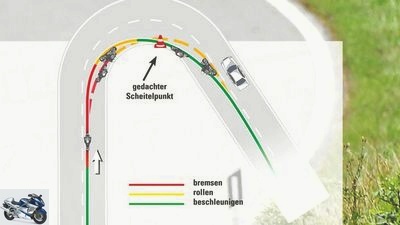
Muller
The classic curve.
The classic curve, which allows a finely arranged ideal line and crisp slopes. Even with the simple curve version it can be seen that when cutting (dashed line) the motorcycle has to drive the greater incline at the curve exit, while the driver moves the apex backwards (pylons) when undercutting (solid line), in this section already again Gas goes and the slightly slower cornering speed more than makes up for it. So: don’t give in too early!
Common mistakes when cornering
Fundamental errors can be described from hundreds of thousands of motorcycle kilometers and the years of experience of the PS editors.
The classic among driving errors: the fear of a great lean angle, with the result that the curve radius ends on the opposite lane. The reason for this is usually a lack of training in banking and cornering speed. Anyone who generally does not trust themselves to be inclined to a great extent has enormous problems if the curve radius is tightening (the so-called dog curve) or the turning speed is too high. Then it is necessary to force the motorcycle into an inclined position by conscious steering impulses. However, this only works if the spirit level in your head allows it. By nature, humans are conditioned to a maximum incline of 20 degrees. If it is to be more, he has to practice. Tip: If it gets really tight, force the motorcycle through the bend using the “push” driving style.

Muller
Even in such situations, there is no practice.
The consequences of “freezing” on the brakes are no less serious. Turned the whisk properly on the straight, then the braking point rushes towards the sportsman faster than he can grasp it. As a result, there is a great deal of panic anchoring with a vengeance. But instead of releasing the brake at the turn-in point and turning it in, the frozen rider remains seated on the anchor and wonders why the bike does not want to turn in, but rather goes straight ahead as if on rails, keyword: stand-up moment. Even in such situations, there is a lack of practice in familiarizing the eyes and brain with high speed and brute delay.
In this case, eye guidance is also very important. Anyone who pauses on the brakes and already sighted the point of impact in the meadow is guaranteed to hit him. Therefore you should force yourself to look into the street.
It doesn’t work without practice! Training on the racetrack or special cornering courses, such as with the MOTORRAD action team, help.
MOTORRAD action team curve school 2014
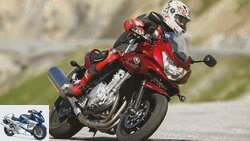
workshop
Cornering Part 1: Technical and psychological basics
Drive properly through the curves
read more
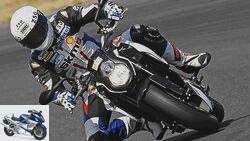
workshop
Cornering Part 2: Creating smooth transitions
Drive properly through the curves
read more
Our best moments
“Everything in the world is wavy. Every country road and so on. Woe to him who puts a ruler everywhere!”, said the German realism writer Wilhelm Raabe around 1900. He hasn’t ridden a motorcycle, but he’s damn right. There is no doubt that curves are the be-all and end-all for motorcyclists – at least for those who have understood the real meaning, this thrill of motorized single-track vehicles. We are therefore all too happy to underline this deeply religious conviction with the phrase “Anyone can go straight ahead” – on T-shirts, for example. As an epigram, this actually belongs in front of every motorway entrance, although the motorway now provides shockingly often the proof that this is not the case.
Disagreement with the guardrail
But not all curves are the same. Even mathematicians know that, for whom there is even something terrible, because there are things that are free of slopes like the “straight curve”. Which, of course, you can define subject-specific, emotionless. With the curve-eating motorcyclist, of course, they only give the impression that they have no trace of the fascination of a curve and certainly not the genius of Marc Marquez. Which is why we give ourselves the definition at this point.
It doesn’t help the maths greats that Albert Einstein, admittedly a millennial genius, was able to prove that he was able to hurry through such a straight curve in curved space at the speed of light. Which would certainly be a tickle, but the feasibility of it still sticks out our tongue.

mps photo studio
PS editor Uwe Seitz.
In any case, you shouldn’t try to go with excessive speeds in the corners that make us so happy. We know that from instinct and experience. Increased heart rate when we see the StVO sign 105, to which the majority of road users respond with “oh dear”, while the hard core of motorcyclists react with “oh yeah”. However, if instinct and experience are deceiving in a curve, the physics has failed to their disadvantage and then, as the seven-time GP world champion Mike Hailwood once described after such a faux pas, “a difference of opinion with the guardrail” has to be resolved. Proof that it can happen to the best.
But what is the risk of falling compared to the emotions as long as things are going well? Happiness hormones flow through us in abundance when we literally scratch the curve. So you paddle your knee over the asphalt or the footrest that touches it gives off sparks. Then we are amazingly close to the medieval coachman, to whom the phrase “scratching a curve” goes back. Because when the boys were in a hurry back then, they actually scratched the corners of the narrow streets with the inside wheel.
“A curve is the loveliest distance between two points”
What already called the order and security fanatics on the scene back then, even before they forbade the pouring of chamber pots into the streets in the musty medieval towns. In order to slow down the completely crazy guys on wheels, so-called curbstones were placed in front of the house wall. The coachmen of course made fun of giving these stone blocks one with the wheel hub in the future. What a wonderful idea, how the little boys in the year 1199 waited on the corner of Farbergasse and Marktstrasse for the “wild Hadubrand” who knew how to take this corner as quickly and narrowly as possible like no other coachman.
That was the birth of the applause curve. Even today, as the Swiss say, such arches or tendrils have a magical attraction to watch others give the Hadubrand. For your physical well-being, supply stations are available in the form of kiosks or small inns, which, from a creative point of view, surprisingly often bear the almost inconceivable name “Die Kurb”. Gladly with the name of the owner. And because we motorcyclists all use our first name. Like “Gunter’s curve” in Kukenbruch – with Anglo-Saxon genitive S, because it looks cooler.
In such places, however, advanced skiers have to be careful! Because whoever plows too briskly through the applause curve in the hanging-off, threatens to get stuck on the “Biker’s welcome” sign that is clearly visible at the apex of the curve. Which is why sports motorcycle riders prefer to go to Burger Ronald for a coffee, if only because they deeply detest the word biker. It smells too much like chopper types who simply have no plan for corners – at least from a driving dynamics point of view.
Which brings us back to the observation that not all curves are the same. Especially when you talk about perfect curves. But no matter whether corkscrew in Laguna Seca or backside of Jennifer Lopez, there is nothing to add to the sentence of the 30s cinema icon Mae West: “A curve is the loveliest distance between two points.”
Related articles
-
The fascination of cornering on a motorcycle
Werel Sports & scene Motorsport The fascination of cornering on a motorcycle The fascination of cornering on a motorcycle And the curve beckons forever…
-
The right tire choice for a motorcycle
Markus Jahn 26th pictures MOTORCYCLE 1/26 On the way on alpine passes? That’s how it works! MOTORCYCLE 2/26 Seductive winding curves with risk. The…
-
Cornering Part 1: Technical and psychological basics
fact counselor workshop Cornering Part 1: Technical and psychological basics Cornering Part 1: Technical and psychological basics Drive properly through…
-
Technology PS driving dynamics cornering ABS
markus-jahn.com 18th pictures markus-jahn.com 1/18 … as well as in the city to its limits. markus-jahn.com 2/18 On the one hand, this smooth transition…
-
Ergonomics and correct sitting
Yvonne Hertler 26th pictures MOTORCYCLE 1/26 On the way on alpine passes? That’s how it works! MOTORCYCLE 2/26 Seductive winding curves with risk. The…
-
archive counselor technology & future Lateral and circumferential forces when riding a motorcycle – driving physics when riding a motorcycle About…
-
Tips for mechanics – correct motorcycle chain maintenance
Photo: Ralf Petersen 13th pictures Ralf Petersen 1/13 / 1 / A typical lack of maintenance: everything sparkling clean, even the chain. Ralf Petersen 2/13…
-
MSC cornering ABS in the test in the KTM 1190 Adventure
Jahn motorcycles MSC cornering ABS in the test in the KTM 1190 Adventure MSC in the KTM 1190 Adventure put to the test ABS suitable for lean angles…
-
fact 23 pictures fact 1/23 Cornering ABS of the BMW HP4. fact 2/23 Cornering ABS of the BMW HP4. fact 3/23 Cornering ABS of the BMW HP4. fact 4/23…
-
Braking properly with the motorcycle
Jahn counselor Driving experience & Driving tips Braking properly with the motorcycle Brake properly Braking with and without ABS Motorcycles ride well…